coolant level DODGE INTREPID 2004 2.G Owners Manual
[x] Cancel search | Manufacturer: DODGE, Model Year: 2004, Model line: INTREPID, Model: DODGE INTREPID 2004 2.GPages: 249, PDF Size: 4.87 MB
Page 118 of 249
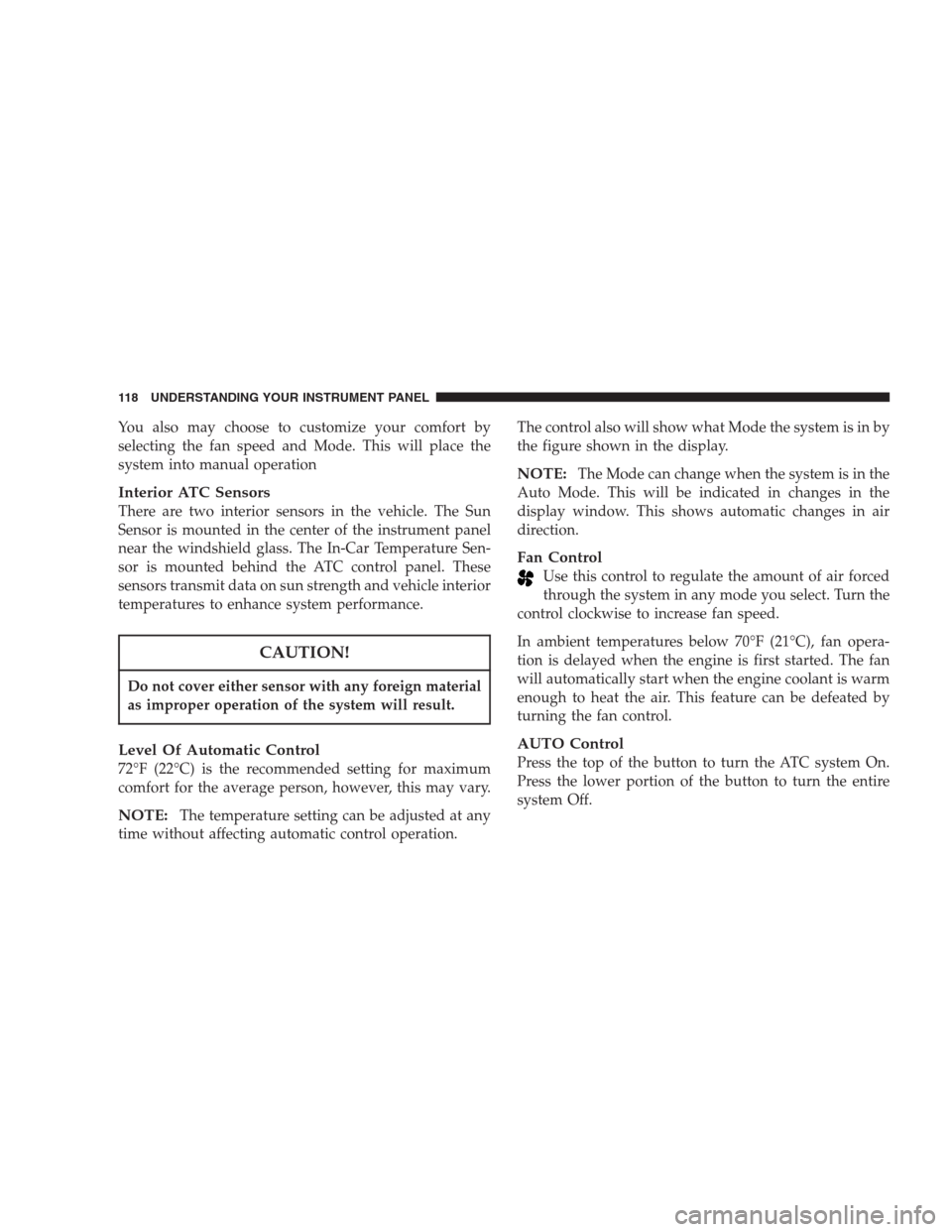
You also may choose to customize your comfort by
selecting the fan speed and Mode. This will place the
system into manual operation
Interior ATC Sensors
There are two interior sensors in the vehicle. The Sun
Sensor is mounted in the center of the instrument panel
near the windshield glass. The In-Car Temperature Sen-
sor is mounted behind the ATC control panel. These
sensors transmit data on sun strength and vehicle interior
temperatures to enhance system performance.
CAUTION!
Do not cover either sensor with any foreign material
as improper operation of the system will result.
Level Of Automatic Control
72°F (22°C) is the recommended setting for maximum
comfort for the average person, however, this may vary.
NOTE:The temperature setting can be adjusted at any
time without affecting automatic control operation.The control also will show what Mode the system is in by
the figure shown in the display.
NOTE:The Mode can change when the system is in the
Auto Mode. This will be indicated in changes in the
display window. This shows automatic changes in air
direction.
Fan Control
Use this control to regulate the amount of air forced
through the system in any mode you select. Turn the
control clockwise to increase fan speed.
In ambient temperatures below 70°F (21°C), fan opera-
tion is delayed when the engine is first started. The fan
will automatically start when the engine coolant is warm
enough to heat the air. This feature can be defeated by
turning the fan control.
AUTO Control
Press the top of the button to turn the ATC system On.
Press the lower portion of the button to turn the entire
system Off.
118 UNDERSTANDING YOUR INSTRUMENT PANEL
Page 149 of 249
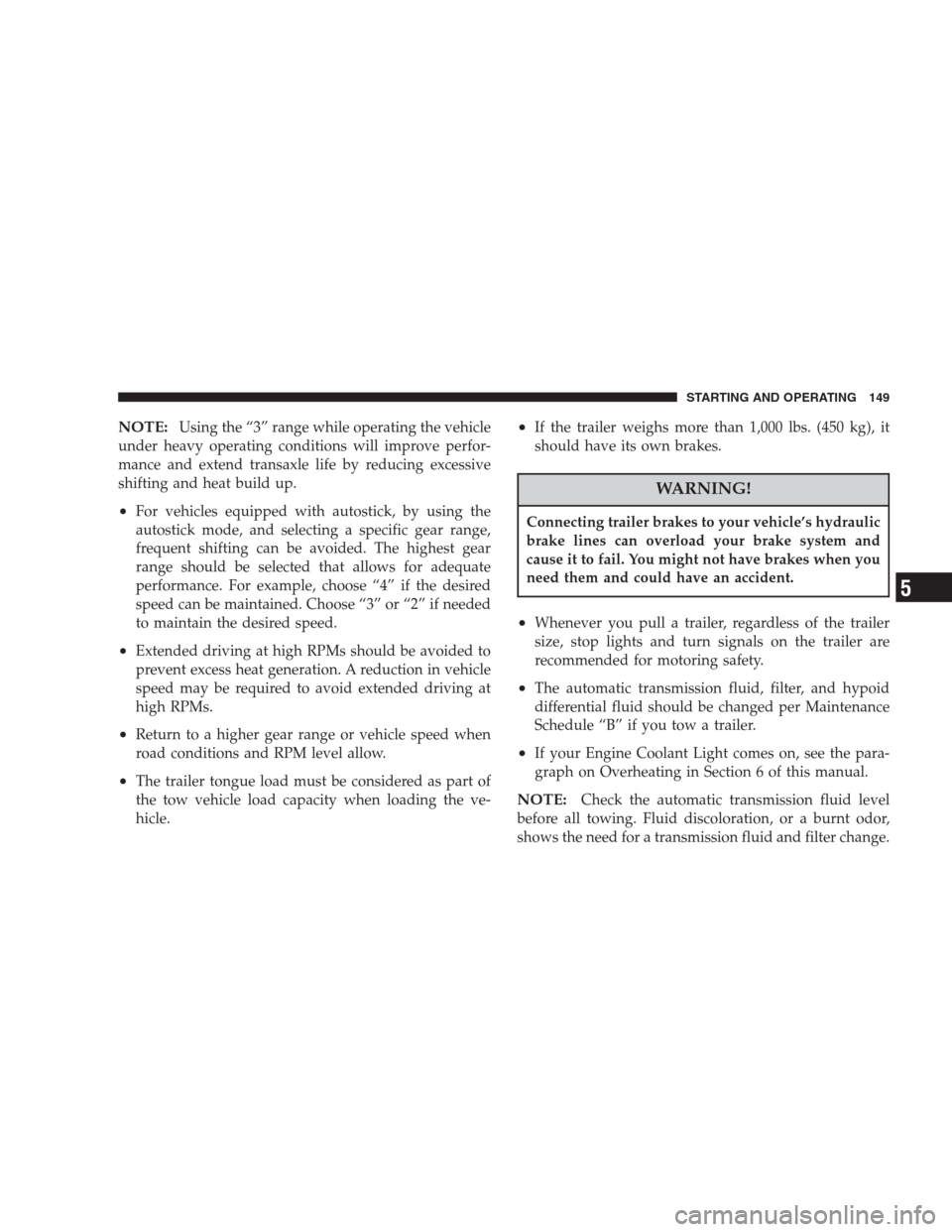
NOTE:Using the “3” range while operating the vehicle
under heavy operating conditions will improve perfor-
mance and extend transaxle life by reducing excessive
shifting and heat build up.
•For vehicles equipped with autostick, by using the
autostick mode, and selecting a specific gear range,
frequent shifting can be avoided. The highest gear
range should be selected that allows for adequate
performance. For example, choose “4” if the desired
speed can be maintained. Choose “3” or “2” if needed
to maintain the desired speed.
•Extended driving at high RPMs should be avoided to
prevent excess heat generation. A reduction in vehicle
speed may be required to avoid extended driving at
high RPMs.
•Return to a higher gear range or vehicle speed when
road conditions and RPM level allow.
•The trailer tongue load must be considered as part of
the tow vehicle load capacity when loading the ve-
hicle.
•If the trailer weighs more than 1,000 lbs. (450 kg), it
should have its own brakes.
WARNING!
Connecting trailer brakes to your vehicle’s hydraulic
brake lines can overload your brake system and
cause it to fail. You might not have brakes when you
need them and could have an accident.
•Whenever you pull a trailer, regardless of the trailer
size, stop lights and turn signals on the trailer are
recommended for motoring safety.
•The automatic transmission fluid, filter, and hypoid
differential fluid should be changed per Maintenance
Schedule “B” if you tow a trailer.
•If your Engine Coolant Light comes on, see the para-
graph on Overheating in Section 6 of this manual.
NOTE:Check the automatic transmission fluid level
before all towing. Fluid discoloration, or a burnt odor,
shows the need for a transmission fluid and filter change.
STARTING AND OPERATING 149
5
Page 189 of 249
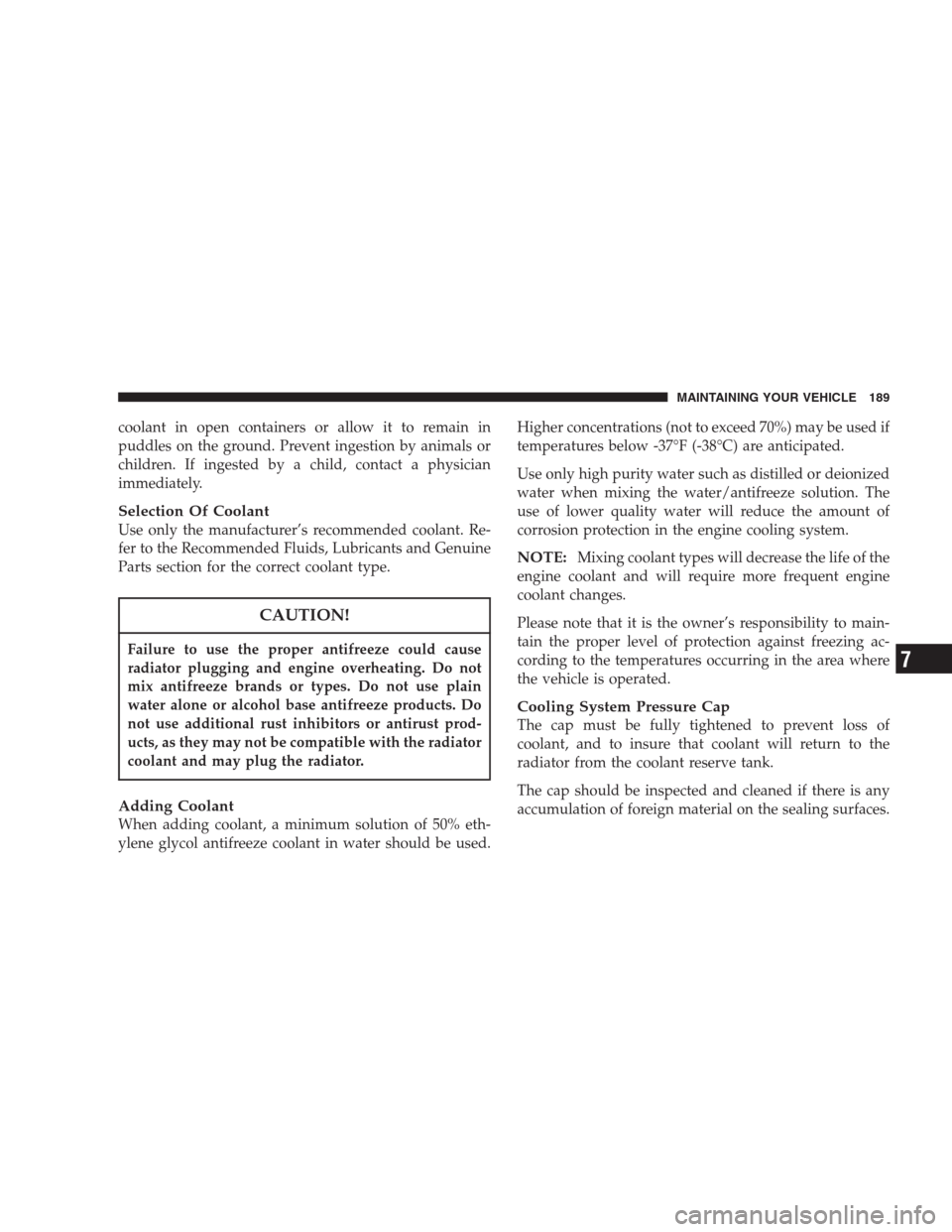
coolant in open containers or allow it to remain in
puddles on the ground. Prevent ingestion by animals or
children. If ingested by a child, contact a physician
immediately.
Selection Of Coolant
Use only the manufacturer’s recommended coolant. Re-
fer to the Recommended Fluids, Lubricants and Genuine
Parts section for the correct coolant type.
CAUTION!
Failure to use the proper antifreeze could cause
radiator plugging and engine overheating. Do not
mix antifreeze brands or types. Do not use plain
water alone or alcohol base antifreeze products. Do
not use additional rust inhibitors or antirust prod-
ucts, as they may not be compatible with the radiator
coolant and may plug the radiator.
Adding Coolant
When adding coolant, a minimum solution of 50% eth-
ylene glycol antifreeze coolant in water should be used.Higher concentrations (not to exceed 70%) may be used if
temperatures below -37°F (-38°C) are anticipated.
Use only high purity water such as distilled or deionized
water when mixing the water/antifreeze solution. The
use of lower quality water will reduce the amount of
corrosion protection in the engine cooling system.
NOTE:Mixing coolant types will decrease the life of the
engine coolant and will require more frequent engine
coolant changes.
Please note that it is the owner’s responsibility to main-
tain the proper level of protection against freezing ac-
cording to the temperatures occurring in the area where
the vehicle is operated.
Cooling System Pressure Cap
The cap must be fully tightened to prevent loss of
coolant, and to insure that coolant will return to the
radiator from the coolant reserve tank.
The cap should be inspected and cleaned if there is any
accumulation of foreign material on the sealing surfaces.
MAINTAINING YOUR VEHICLE 189
7
Page 190 of 249

WARNING!
The warning words “DO NOT OPEN HOT” on the
cooling system pressure cap are a safety precaution.
Never add coolant when the engine is overheated.
Do not loosen or remove the cap to cool an over-
heated engine. Heat causes pressure to build up in
the cooling system. To prevent scalding or injury, do
not remove the pressure cap while the system is hot
or under pressure.
WARNING!
Do not use a pressure cap other than the one speci-
fied for your vehicle. Personal injury or engine
damage may result.
Coolant Level
The coolant bottle provides a quick visual method for
determining that the coolant level is adequate. With theengine Off and cold, the level of the coolant in the bottle
should be between the MIN and MAX cold fill lines.
When additional coolant is needed to maintain the
proper level, it should be added to the coolant bottle. Do
not overfill.
190 MAINTAINING YOUR VEHICLE
Page 191 of 249
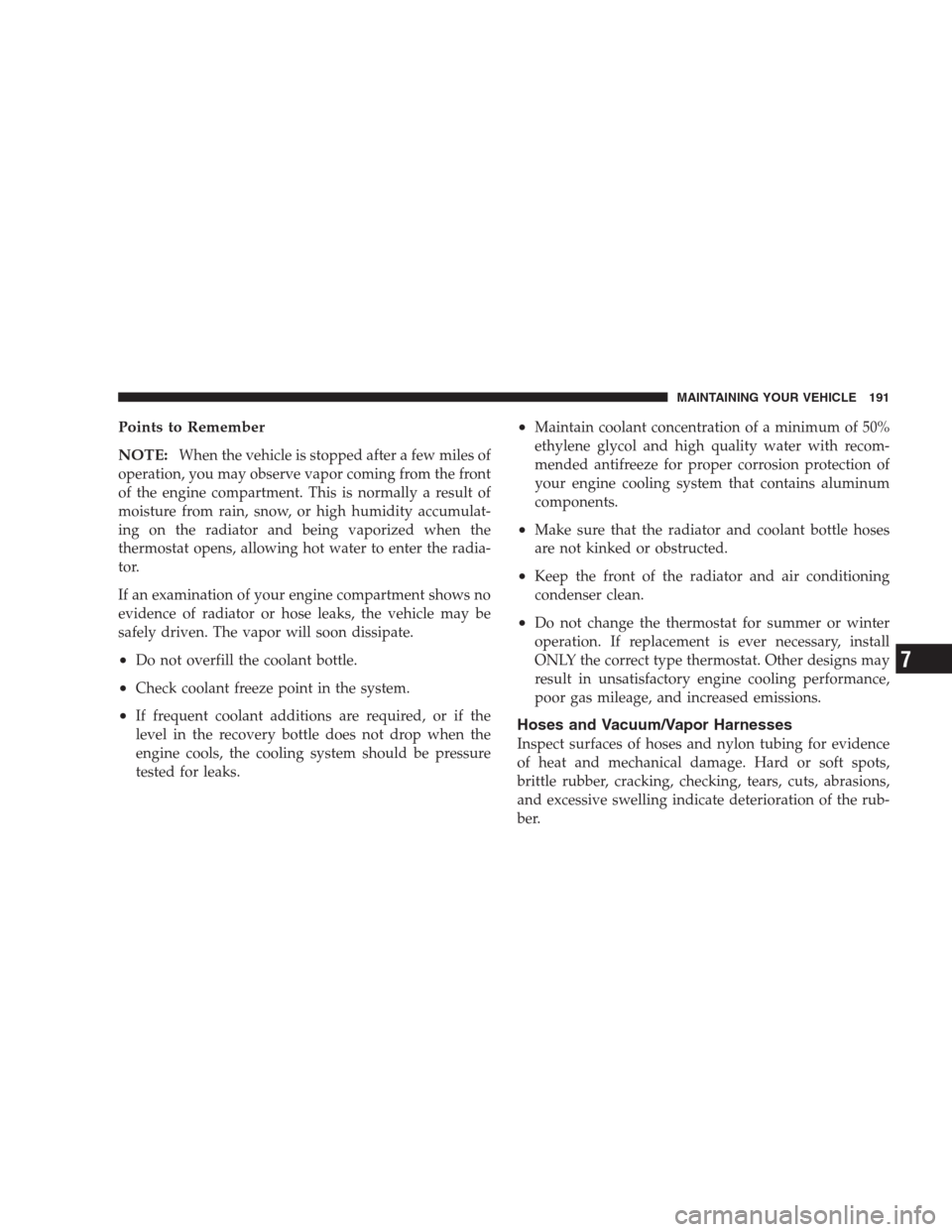
Points to Remember
NOTE:
When the vehicle is stopped after a few miles of
operation, you may observe vapor coming from the front
of the engine compartment. This is normally a result of
moisture from rain, snow, or high humidity accumulat-
ing on the radiator and being vaporized when the
thermostat opens, allowing hot water to enter the radia-
tor.
If an examination of your engine compartment shows no
evidence of radiator or hose leaks, the vehicle may be
safely driven. The vapor will soon dissipate.
•Do not overfill the coolant bottle.
•Check coolant freeze point in the system.
•If frequent coolant additions are required, or if the
level in the recovery bottle does not drop when the
engine cools, the cooling system should be pressure
tested for leaks.
•Maintain coolant concentration of a minimum of 50%
ethylene glycol and high quality water with recom-
mended antifreeze for proper corrosion protection of
your engine cooling system that contains aluminum
components.
•Make sure that the radiator and coolant bottle hoses
are not kinked or obstructed.
•Keep the front of the radiator and air conditioning
condenser clean.
•Do not change the thermostat for summer or winter
operation. If replacement is ever necessary, install
ONLY the correct type thermostat. Other designs may
result in unsatisfactory engine cooling performance,
poor gas mileage, and increased emissions.
Hoses and Vacuum/Vapor Harnesses
Inspect surfaces of hoses and nylon tubing for evidence
of heat and mechanical damage. Hard or soft spots,
brittle rubber, cracking, checking, tears, cuts, abrasions,
and excessive swelling indicate deterioration of the rub-
ber.
MAINTAINING YOUR VEHICLE 191
7
Page 208 of 249
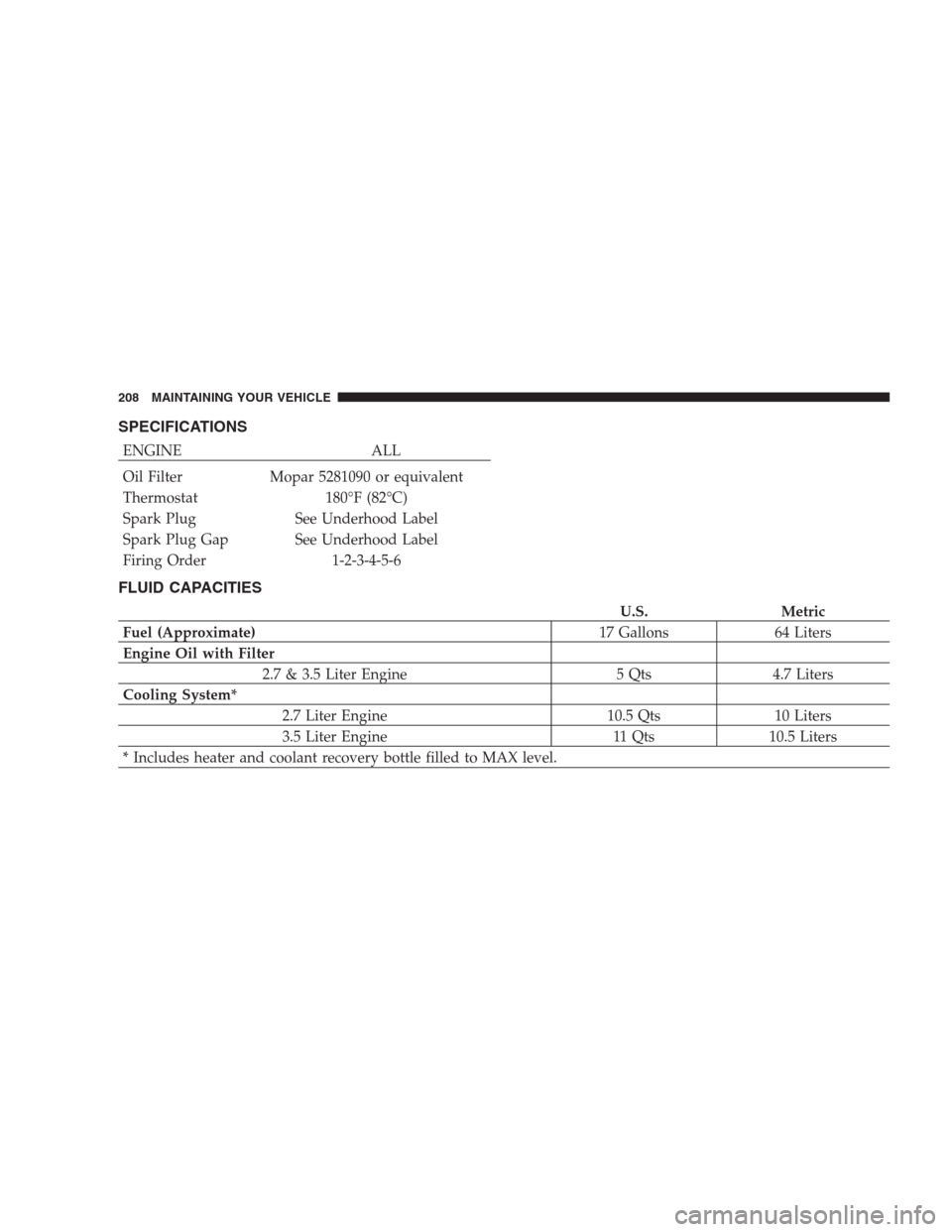
SPECIFICATIONS
ENGINE ALL
Oil Filter Mopar 5281090 or equivalent
Thermostat 180°F (82°C)
Spark Plug See Underhood Label
Spark Plug Gap See Underhood Label
Firing Order 1-2-3-4-5-6
FLUID CAPACITIES
U.S. Metric
Fuel (Approximate)17 Gallons 64 Liters
Engine Oil with Filter
2.7 & 3.5 Liter Engine 5 Qts 4.7 Liters
Cooling System*
2.7 Liter Engine 10.5 Qts 10 Liters
3.5 Liter Engine 11 Qts 10.5 Liters
* Includes heater and coolant recovery bottle filled to MAX level.
208 MAINTAINING YOUR VEHICLE
Page 214 of 249
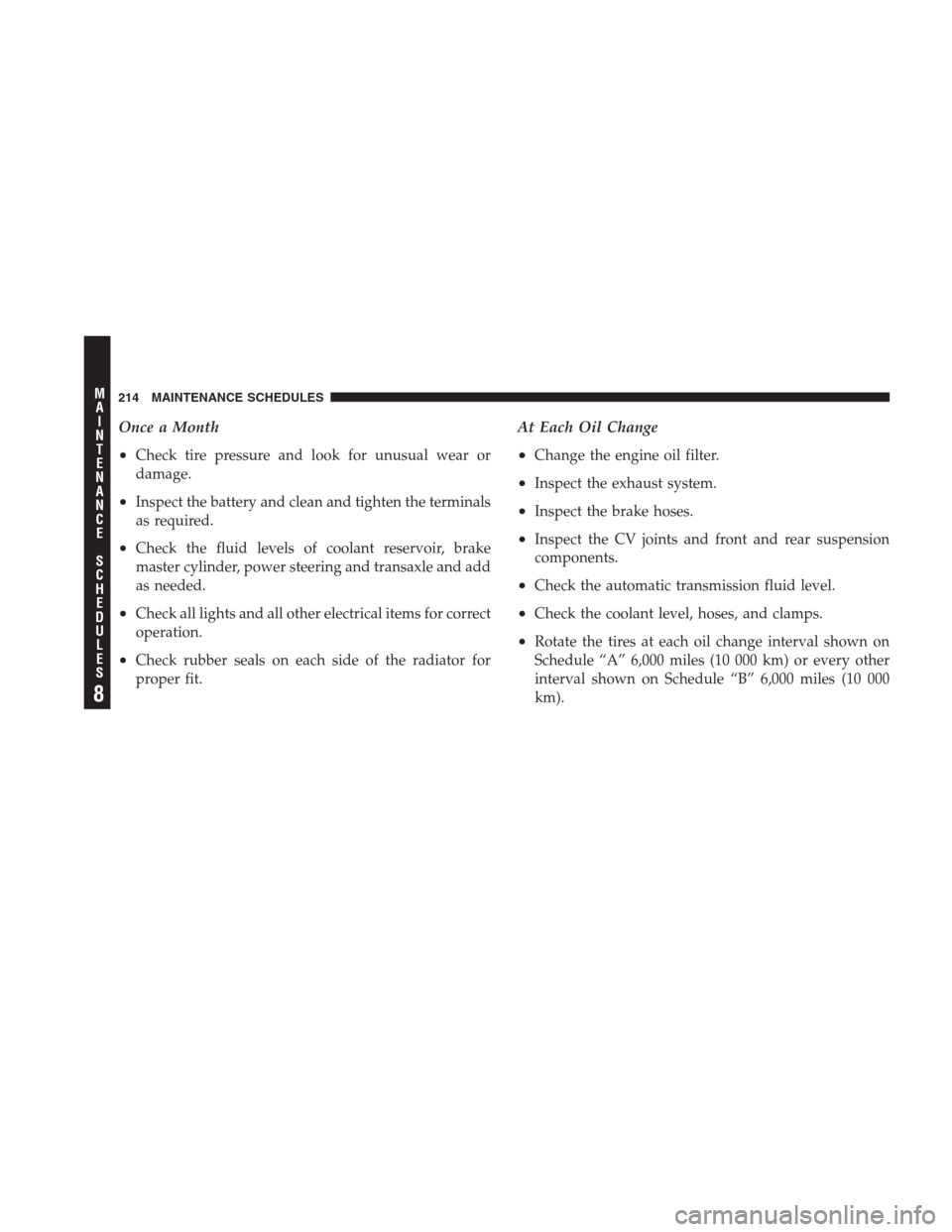
Once a Month
•
Check tire pressure and look for unusual wear or
damage.
•Inspect the battery and clean and tighten the terminals
as required.
•Check the fluid levels of coolant reservoir, brake
master cylinder, power steering and transaxle and add
as needed.
•Check all lights and all other electrical items for correct
operation.
•Check rubber seals on each side of the radiator for
proper fit.
At Each Oil Change
•
Change the engine oil filter.
•Inspect the exhaust system.
•Inspect the brake hoses.
•Inspect the CV joints and front and rear suspension
components.
•Check the automatic transmission fluid level.
•Check the coolant level, hoses, and clamps.
•Rotate the tires at each oil change interval shown on
Schedule “A” 6,000 miles (10 000 km) or every other
interval shown on Schedule “B” 6,000 miles (10 000
km).
214 MAINTENANCE SCHEDULES
8
M
A
I
N
T
E
N
A
N
C
E
S
C
H
E
D
U
L
E
S
Page 238 of 249

About Your Brakes...................... 134
ABS (Anti-Lock Brake) System...........91,134
Accident Damage....................... 199
Adding Engine Coolant (Antifreeze)......... 189
Adding Fuel.......................... 146
Air Cleaner, Engine..................... 180
Air Conditioner Maintenance.............. 182
Air Conditioning.................... 114,117
Air Conditioning Controls............. 114,117
Air Conditioning, Operating Tips........... 123
Air Conditioning Refrigerant.............. 182
Air Conditioning System................. 182
Air Pressure, Tires...................136,137
Airbag................................ 33
Airbag Deployment....................36,37
Airbag Light.....................37,40,48,90
Airbag Maintenance...................... 39
Alarm System.......................... 23
Alignment and Balance.................. 143
Antifreeze Disposal..................... 188
Antifreeze (Engine Coolant)............... 189
Anti-Lock Brake System.................. 134
Anti-Lock Warning Light.................. 91Anti-Theft Security Alarm................. 23
Anti-Theft System....................... 23
Appearance Care....................... 197
Auto Down Power Windows............... 25
Automatic Door Locks.................... 16
Automatic Mirrors....................... 53
Automatic Off, Interior Lights.............. 60
Automatic Temperature Control............ 117
Automatic Transaxle..................129,194
Fluid and Filter Changes................ 197
Fluid Level Check..................... 195
Reset Mode......................... 130
Selection Of Lubricant................. 194
Shifting............................ 130
Special Additives..................... 197
Backfire, Engine........................ 180
Ball Joints............................ 184
Battery............................158,181
Emergency Starting.................... 158
Gas Caution......................158,181
Jump Starting........................ 158
Keyless Transmitter Replacement.......... 22
238 INDEX
Page 240 of 249
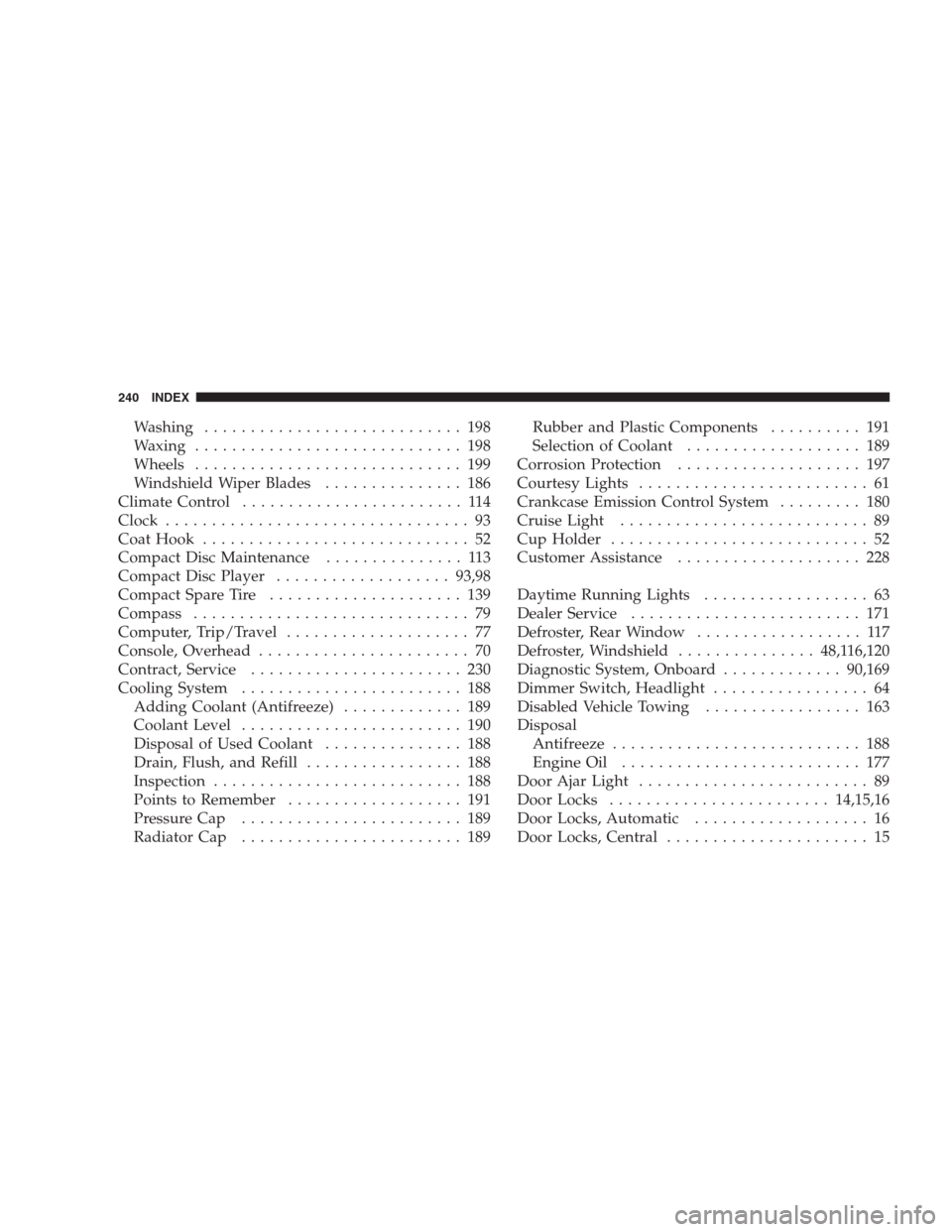
Washing............................ 198
Waxing............................. 198
Wheels............................. 199
Windshield Wiper Blades............... 186
Climate Control........................ 114
Clock................................. 93
Coat Hook............................. 52
Compact Disc Maintenance............... 113
Compact Disc Player...................93,98
Compact Spare Tire..................... 139
Compass.............................. 79
Computer, Trip/Travel.................... 77
Console, Overhead....................... 70
Contract, Service....................... 230
Cooling System........................ 188
Adding Coolant (Antifreeze)............. 189
Coolant Level........................ 190
Disposal of Used Coolant............... 188
Drain, Flush, and Refill................. 188
Inspection........................... 188
Points to Remember................... 191
Pressure Cap........................ 189
Radiator Cap........................ 189Rubber and Plastic Components.......... 191
Selection of Coolant................... 189
Corrosion Protection.................... 197
Courtesy Lights......................... 61
Crankcase Emission Control System......... 180
Cruise Light........................... 89
Cup Holder............................ 52
Customer Assistance.................... 228
Daytime Running Lights.................. 63
Dealer Service......................... 171
Defroster, Rear Window.................. 117
Defroster, Windshield...............48,116,120
Diagnostic System, Onboard.............90,169
Dimmer Switch, Headlight................. 64
Disabled Vehicle Towing................. 163
Disposal
Antifreeze........................... 188
Engine Oil.......................... 177
Door Ajar Light......................... 89
Door Locks........................14,15,16
Door Locks, Automatic................... 16
Door Locks, Central...................... 15
240 INDEX